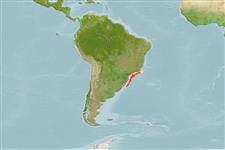Environment: milieu / climate zone / depth range / distribution range
Écologie
marin démersal; profondeur 100 - 200 m (Ref. 47377). Subtropical; 22°S - 32°S
Distribution
Pays | Zones FAO | Écosystèmes | Occurrences | Point map | Introductions | Faunafri
Southwest Atlantic: Rio de Janeiro (Cabo Frio) to Rio Grande do Sul.
Taille / Poids / Âge
Maturity: Lm ? range ? - ? cm
Max length : 23.0 cm TL mâle / non sexé; (Ref. 47377)
Caught with deepwater trawls in depths between 100 and 200 m on the Brazilian shelf (Ref. 47377).
Life cycle and mating behavior
Maturité | Reproduction | Frai | Œufs | Fécondité | Larves
Figueiredo, J.L. de, A.P. dos Santos, N. Yamaguti, R.A. Bernardes and C.L. Del Bianco Rossi-Wongtschowski, 2002. Peixes da zona econômica exclusiva da Região Sudeste-Sul do Brasil: Levantamento com Rede de Meia-Água. São-Paulo: Editora da Universidade de São Paulo; Imprensa Oficial do Estado, 242 p. (Ref. 47377)
Statut dans la liste rouge de l'IUCN (Ref. 130435: Version 2024-1)
Menace pour l'homme
Harmless
Utilisations par l'homme
Pêcheries: sans intérêt
Outils
Articles particuliers
Télécharger en XML
Sources Internet
Estimates based on models
Phylogenetic diversity index (Ref.
82804): PD
50 = 0.5000 [Uniqueness, from 0.5 = low to 2.0 = high].
Bayesian length-weight: a=0.00525 (0.00324 - 0.00851), b=3.01 (2.87 - 3.15), in cm total length, based on LWR estimates for this species & Genus-body shape (Ref.
93245).
Niveau trophique (Ref.
69278): 3.5 ±0.3 se; based on size and trophs of closest relatives
Résilience (Ref.
120179): Milieu, temps minimum de doublement de population : 1,4 à 4,4 années (Preliminary K or Fecundity.).
Fishing Vulnerability (Ref.
59153): Low vulnerability (13 of 100).
